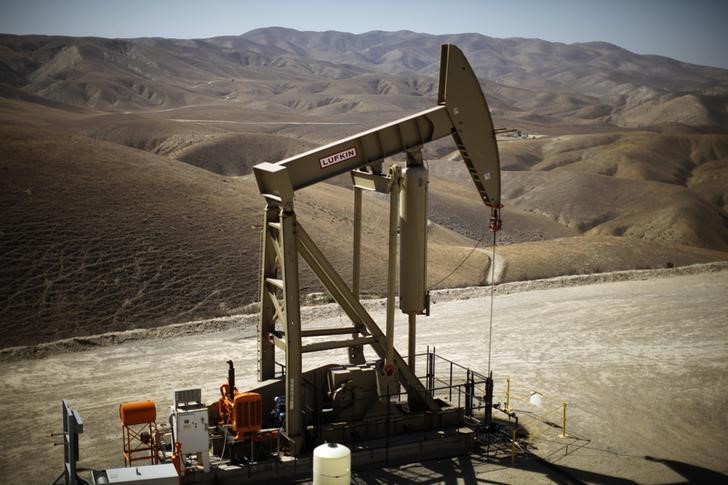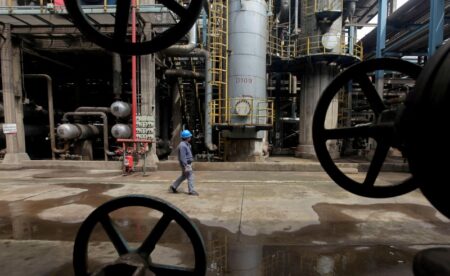By Alexander Villegas and Eliana Raszewski
ANELO, Argentina (Reuters) – Argentina’s new market-friendly government and fears about oil supply from the Middle East and elsewhere are driving a drilling and production boom in Argentina’s Patagonian south, home to the giant Vaca Muerta shale formation, Spanish for “Dead Cow”.
Shale oil and gas output is soaring in the flat, arid landscape. Fracking wells are being drilled at record pace, pipelines built to take gas north to the capital Buenos Aires – and eventually beyond once liquefied (LNG) plants come online.
“Our energy future is being built here,” proclaims a huge blue billboard from state energy giant YPF outside the shale town of Anelo, where new homes are being built fast. The town’s population swelled 10% in the last year.
Argentina’s embattled government, under pro-industry libertarian President Javier Milei, is pushing oil and gas exports to bring in needed foreign currency to build up reserves, and is also rolling out sweeteners for big investment.
Vaca Muerta, an area the size of Belgium, holds the world’s second largest shale gas reserves and fourth for shale oil. Still a relative frontier in the global energy scene, it has huge promise.
Investors are more than ready to welcome a new and stable source of oil and LNG at a time of mounting conflict in the oil-rich Middle East while gas giant Russia wages war in Ukraine and Venezuela remains a pariah.
In oil towns like Anelo, the rapid rise in activity is clear: only a few decades ago it was a sleepy hamlet with a handful of houses. Now it has hotels, restaurants and even a casino for energy sector workers flocking there in droves.
“The boom is already here,” said Monica Paredes, 70, one of the first residents in Anelo as she sat in front of her home of almost half a century near the town’s central plaza. “There was nothing here before, nothing.”
The local governor says Anelo has added 1,000 residents in the last year. This has strained local infrastructure. a broader challenge for growth.
Thousands of oil executives are flocking to the region for a major energy summit starting on Wednesday, with infrastructure, LNG export plans and energy deals on the table. Hotels in and around capital Neuquen are booked out.
“Growth is so dizzying that infrastructure cannot keep up with the speed of growth of the number people,” said José Luis Sureda, former secretary of hydrocarbon resources of Argentina.
GLOBAL ENERGY PLAYER BY 2030?
Vaca Muerta has the potential to be a crown jewel for Argentina, which has battled economic crises for years with depleted foreign currency reserves, triple-digit inflation and whipsaw political shifts between left and right.
Some of those concerns remain, but libertarian Milei has changed the mood for investors, rolling out policies aimed at boosting the private sector and austerity measures to right the economy – even as poverty has risen.
An investment incentive scheme is giving large projects in areas such as energy and mining tax breaks and better access to controlled foreign currency markets, spurring investment.
The main hurdle remains getting the logistics right. Argentina still lacks LNG export capacity, which will take years to full build out. Local roads, schools and housing in places like Anelo still need to catch up.
Sureda said new oil development would outpace gas in the years ahead because oil is easier to ship to global markets, despite pipeline bottlenecks. Gas faces a more complicated challenge: a lack of plants to turn it into LNG for export.
“Vaca Muerta can provide 2 million barrels per day without any problem,” Sureda added. Argentina’s shale oil production currently is around 400,000 barrels per day.
“But for that to happen, other things are needed: more infrastructure to bring the oil to the ports, and many more people in the workforce and more equipment.”
More people are starting to believe the dream that Argentina could become a serious global energy player. The number of fracking wells to extract shale oil and gas has surged this year. Investment is up. Production is hitting records.
“Argentina, if everything goes well, could be a global player by 2030,” said Daniel Dreizzen, director of consultancy firm Aleph Energy and former secretary of energy planning.
One key focus for energy firms is Argentina’s ability to build up its pipelines and gas export terminals. A major LNG terminal deal between YPF and Malaysia’s Petronas is wobbling, industry insiders said, underscoring the challenge.
Even if it goes ahead, it would take years and billions of dollars.
“Oil is very profitable, but gas needs more infrastructure,” said Dreizzen, who predicted annual sector investment could almost double to some $23 billion in the next eight years.
“You have to build pipelines, liquefy it, transport it, compete with the United States. It is a long-term project.”
Read the full article here
















